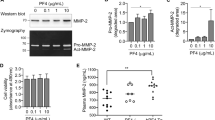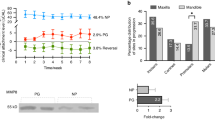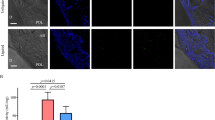Abstract
Polymorphonuclear neutrophils (PMNs) are attracted to sites of infection by N-formylpeptide (fMLP) chemoattractants. The high-affinity fMLP receptor (FPR1) of phagocytic cells interacts with bacterial fMLP and mediates chemotaxis, degranulation, and superoxide production. These cellular functions are disrupted in PMN from aggressive periodontitis (AP) patients. Two FPR1 gene single nucleotide polymorphisms (SNPs), c.329T>C and c.378C>G, have been associated with a localized form of AP in African-American patients. To evaluate the generality of these SNPs in AP patients, we sequenced a 363 bp interval of the FPR1 gene in an ethnically diverse group of patients (n=111) and controls (n=115). Neither c.329T>C nor c.378C>G were detected in the 452 alleles sequenced. Six SNPs were identified including two located in the FPR1 second extracellular loop that were significantly associated with the AP phenotype in African-American patients (p.R190W, P=0.0033; and p.N192K, P=0.0018). These two SNPs show three predominant haplotypes, each associated with a different disease risk in African-Americans. These data do not support the hypothesis that the FPR1 SNPs c.329T>C and c.378C>G play an etiologic role in aggressive periodontitis, but do suggest that SNPs in the second extracellular loop may be etiologically important.
This is a preview of subscription content, access via your institution
Access options
Subscribe to this journal
Receive 6 digital issues and online access to articles
$119.00 per year
only $19.83 per issue
Buy this article
- Purchase on SpringerLink
- Instant access to full article PDF
Prices may be subject to local taxes which are calculated during checkout



Similar content being viewed by others

Accession codes
References
Van Dyke TE, Levine MJ, Tabak LA, Genco RJ . Reduced chemotactic peptide binding in juvenile periodontitis: a model for neutrophil function. Biochem Biophys Res Commun 1981; 100: 1278–1284.
Sigusch B, Eick S, Pfister W, Klinger G, Glockmann E . Altered chemotactic behavior of crevicular PMNs in different forms of periodontitis. J Clin Periodontol 2001; 28: 162–167.
Hurttia H, Saarinen K, Leino L . Increased adhesion of peripheral blood neutrophils from patients with localized juvenile periodontitis. J Periodontal Res 1998; 33: 292–297.
Biasi D, Bambara LM, Carletto A et al. Neutrophil migration, oxidative metabolism and adhesion in early onset perio-dontitis. J Clin Periodontol 1999; 26: 563–568.
Daniel MA, McDonald G, Offenbacher S, Van Dyke TE . Defective chemotaxis and calcium response in localized juvenile periodontitis neutrophils. J Periodontol 1993; 64: 617–621.
Sigusch B, Klinger G, Holtz H, Suss J . In vitro phagocytosis by crevicular phagocytes in various forms of periodontitis. J Periodontol 1992; 63: 496–501.
Online Mendelian Inheritance in Man, OMIM (TM). Johns Hopkins University, Baltimore, MD. MIM Number: {136537}: {6/21/00}: {136538}: {3/20/01}: {136539}: {7/2/98}. World Wide Web URL: http://www.ncbi.nlm.nih.gov/omim/.
Genco RJ, Christersson LA, Zambon JJ . Juvenile periodontitis. Int Dent J 1986; 36: 168–176.
Perez HD, Kelly E, Elfman F, Armitage G, Winkler J . Defective polymorphonuclear leukocyte formyl peptide receptor(s) in juvenile periodontitis. J Clin Invest 1991; 87: 971–976.
Agarwal S, Suzuki JB, Riccelli AE . Role of cytokines in the modulation of neutrophil chemotaxis in localized juvenile periodontitis. J Periodontal Res 1994; 29: 127–137.
Offenbacher S . Periodontal diseases: pathogenesis. Ann Periodontol 1996; 1: 821–878.
Gwinn MR, Sharma A, De Nardin E . Single nucleotide polymorphisms of the N-formyl peptide receptor in localized juvenile periodontitis. J Periodontol 1999; 70: 1194–1201.
1999 International Workshop for a Classification of Periodontal Diseases and Conditions. Papers. Oak Brook, Illinois, 30 October–2 November, 1999. Ann Periodontol 1999; 4: 1–112.
Boulay F, Tardif M, Brouchon L, Vignais P . The human N-formylpeptide receptor. Characterization of two cDNA isolates and evidence for a new subfamily of G-protein-coupled receptors. Biochemistry 1990; 29: 11123–11133.
Boulay F, Tardif M, Brouchon L, Vignais P . Synthesis and use of a novel N-formyl peptide derivative to isolate a human N-formyl peptide receptor cDNA. Biochem Biophys Res Commun 1990; 168: 1103–1109.
Murphy PM, Ozcelik T, Kenney RT, Tiffany HL, McDermott D, Francke U . A structural homologue of the N-formyl peptide receptor. Characterization and chromosome mapping of a peptide chemoattractant receptor family. J Biol Chem 1992; 267: 7637–7643.
De Nardin E, Radel SJ, Lewis N, Genco RJ, Hammarskjold M . Identification of a gene encoding for the human formyl peptide receptor. Biochem Int 1992; 26: 381–387.
Sahagun-Ruiz A, Colla JS, Juhn J, Gao J-L, Murphy PM, McDermott DH . Contrasting evolution of the human leukocyte N-formylpeptide receptor subtypes FPR and FPRL1R. Genes Immun 2001; 2: 335–342.
Marazita ML, Burmeister JA, Gunsolley JC, Koertge TE, Lake K, Schenkein HA . Evidence for autosomal dominant inheritance and race-specific heterogeneity in early-onset perio-dontitis. J Periodontol 1994; 65: 623–630.
Perez HD, Kelly E, Elfman F, Armitage G, Winkler J . Defective polymorphonuclear leukocyte formyl peptide receptor(s) in juvenile periodontitis. J Clin Invest 1991; 87: 971–976.
Mattout C, Mege JL, Mattout P, Fourel J, Monnet V . Function of polynuclear neutrophils in patients with juvenile periodontitis and rapidly progressing periodontitis. J Parodontol 1990; 9: 189–193.
Ye RD, Cavanagh SL, Quehenberger O, Prossnitz ER, Cochrane CG . Isolation of a cDNA that encodes a novel granulocyte N-formyl peptide receptor. Biochem Biophys Res Commun 1992; 184: 582–589.
Quehenberger O, Prossnitz ER, Cavanagh SL, Cochrane CG, Ye RD . Multiple domains of the N-formyl peptide receptor are required for high-affinity ligand binding. Construction and analysis of chimeric N-formyl peptide receptors. J Biol Chem 1993; 268: 18167–18175.
Lala A, Gwinn M, De Nardin E . Human formyl peptide receptor function role of conserved and nonconserved charged residues. Eur J Biochem 1999; 264: 495–499.
Seifert R, Wenzel-Seifert K . Defective Gi protein coupling in two formyl peptide receptor mutants associated with localized juvenile periodontitis. J Biol Chem 2001; 276: 42043–42049.
Zhang Y, Gorry MC, Hart PS et al. Localization, genomic organization, and alternative transcription of a novel human SAM-dependent methyltransferase gene on chromosome 2p21-p22. Cytogenet Cell Genet 2001; 95: 146–152.
Hart PS, Zhang Y, Firatli E et al. Identification of cathepsin C mutations in ethnically diverse Papillon–Lefevre syndrome patients. J Med Genet 2000; 37: 927–932.
Acknowledgements
This investigation was supported in part by United States Public Health Service research grants DE12920, DE13499, and DE10990 from the National Institute of Dental and Craniofacial Research, National Institute of Health.
Author information
Authors and Affiliations
Corresponding author
Rights and permissions
About this article
Cite this article
Zhang, Y., Syed, R., Uygar, C. et al. Evaluation of human leukocyte N-formylpeptide receptor (FPR1) SNPs in aggressive periodontitis patients. Genes Immun 4, 22–29 (2003). https://doi.org/10.1038/sj.gene.6363900
Published:
Issue date:
DOI: https://doi.org/10.1038/sj.gene.6363900
Keywords
This article is cited by
-
Formyl peptide receptors in the mucosal immune system
Experimental & Molecular Medicine (2020)
-
Honokiol suppresses formyl peptide-induced human neutrophil activation by blocking formyl peptide receptor 1
Scientific Reports (2017)
-
Enemy attraction: bacterial agonists for leukocyte chemotaxis receptors
Nature Reviews Microbiology (2015)
-
Variable responses of formyl peptide receptor haplotypes toward bacterial peptides
Immunogenetics (2008)
-
Analysis of a missense variant of the human N-formyl peptide receptor that is associated with agonist-independent β-arrestin association and indices of inflammation
The Pharmacogenomics Journal (2007)


